Charles E W Bean, Diaries, AWM38 3DRL 606/266/1 - September 1918 - Part 4
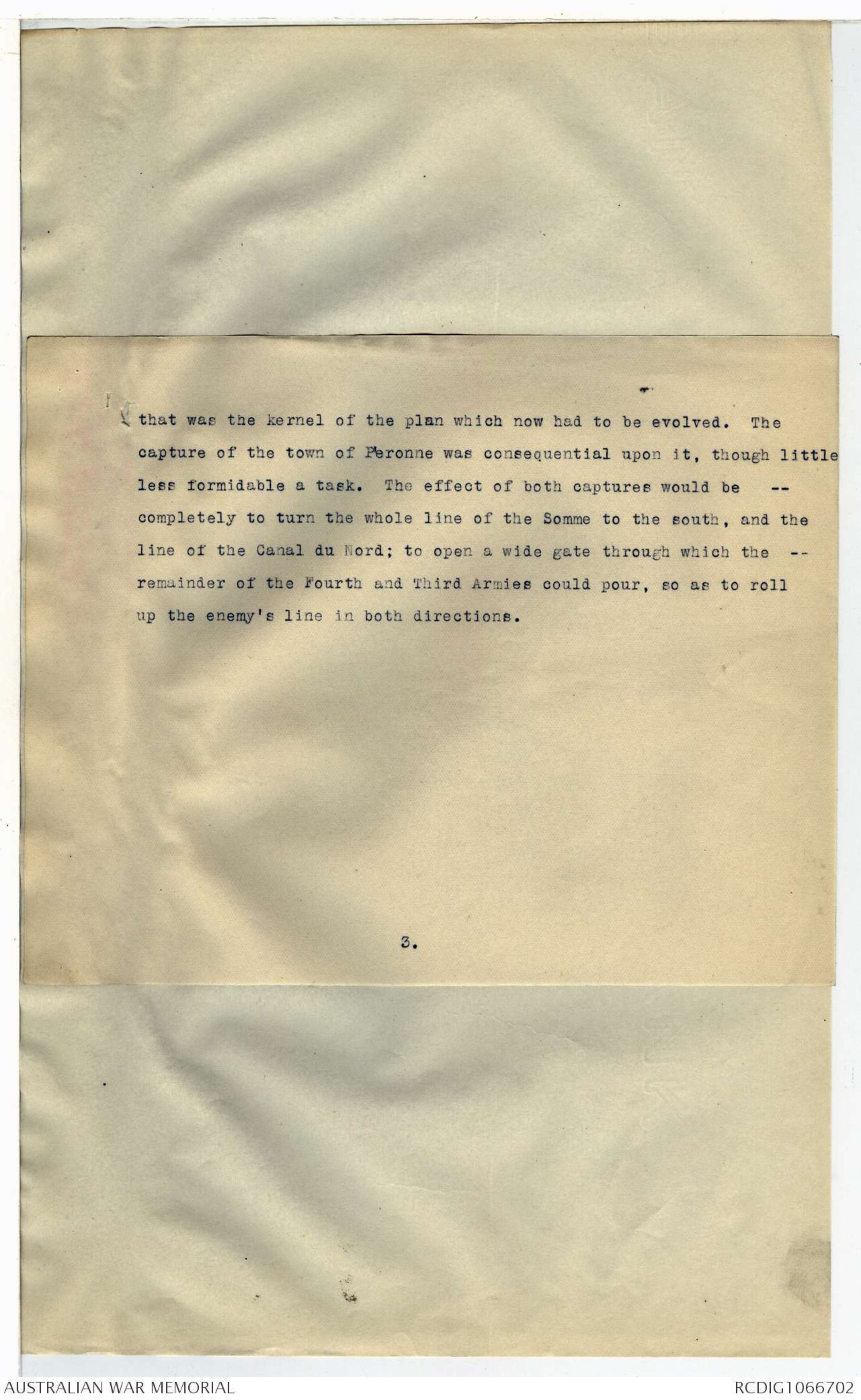
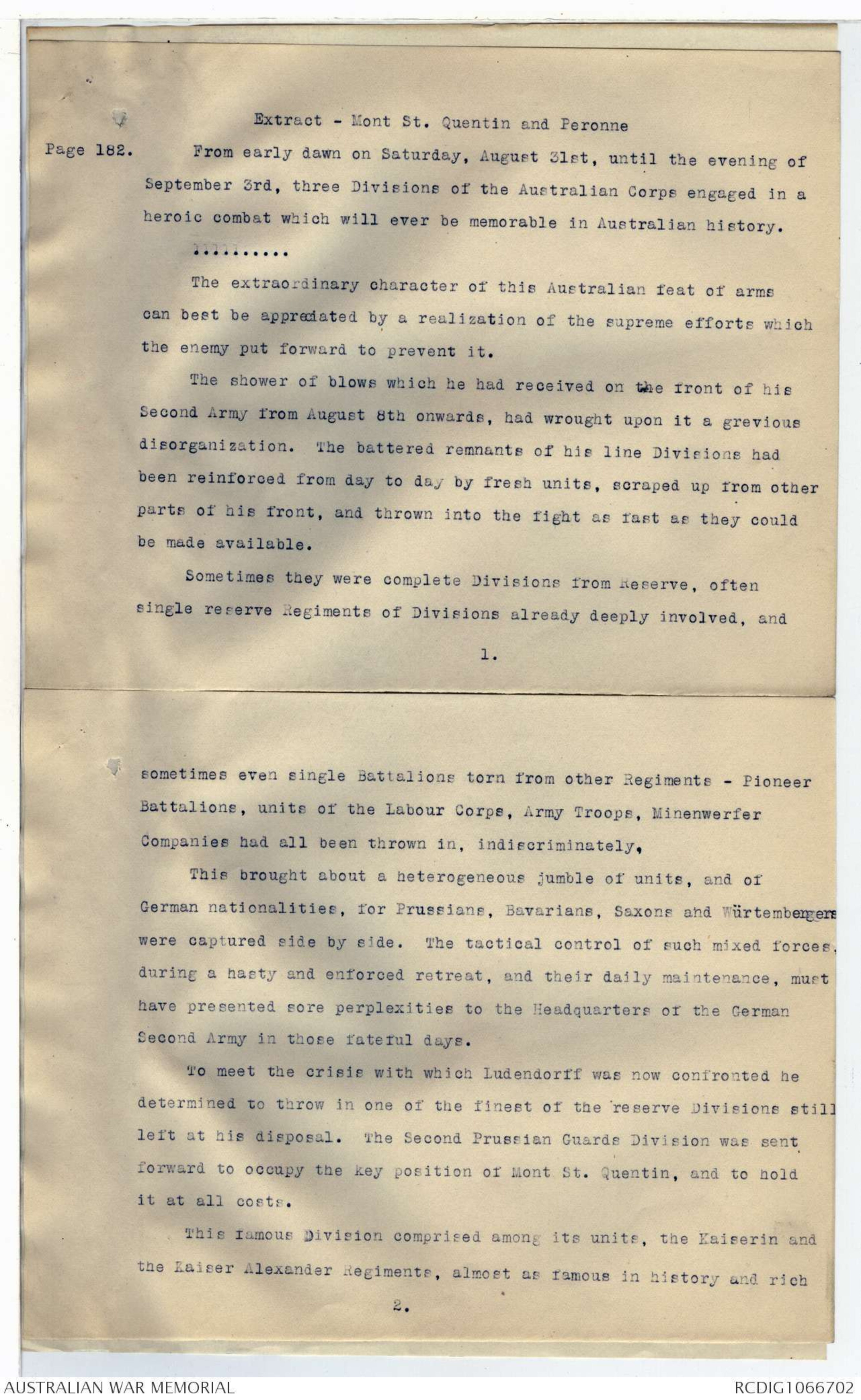

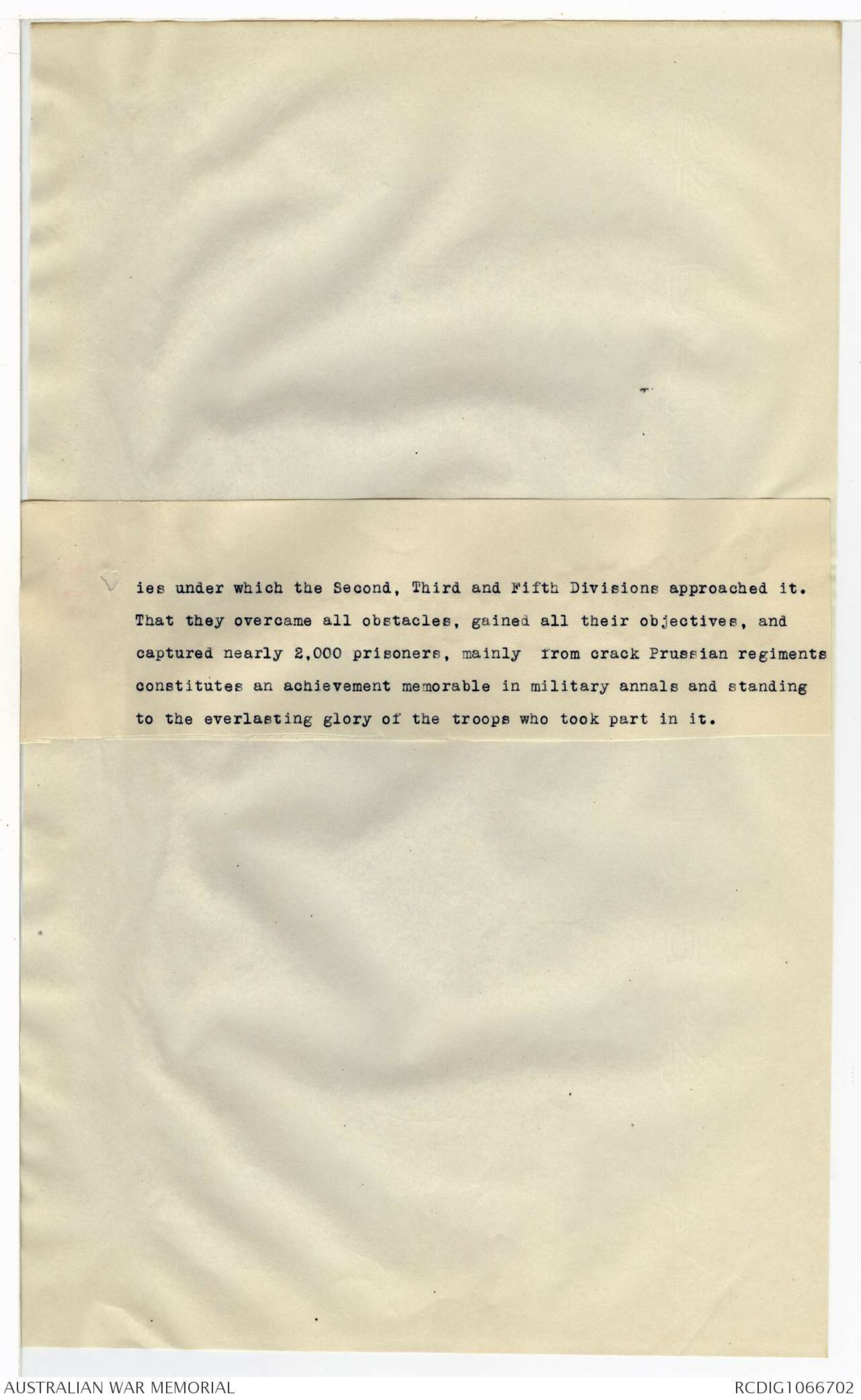
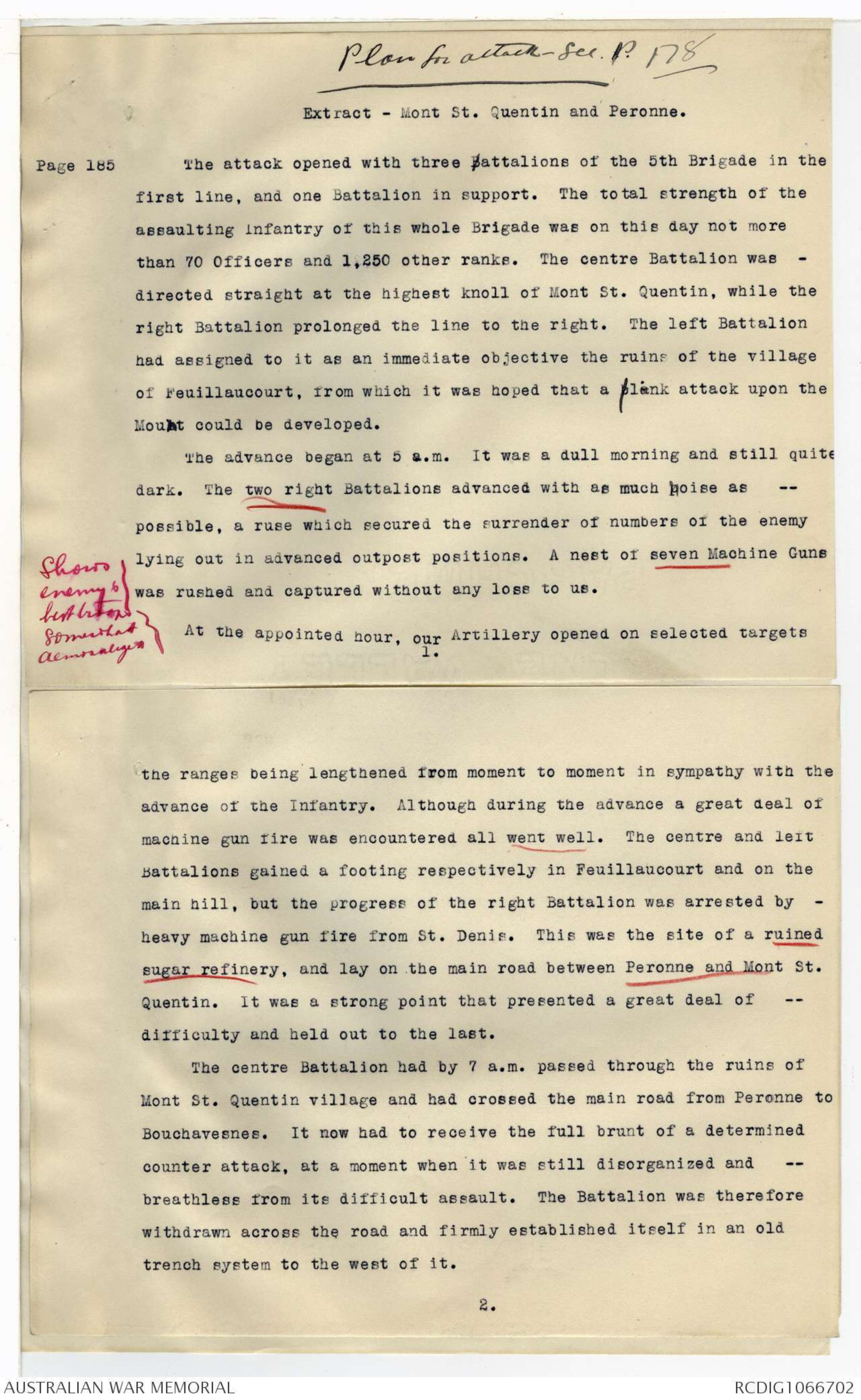
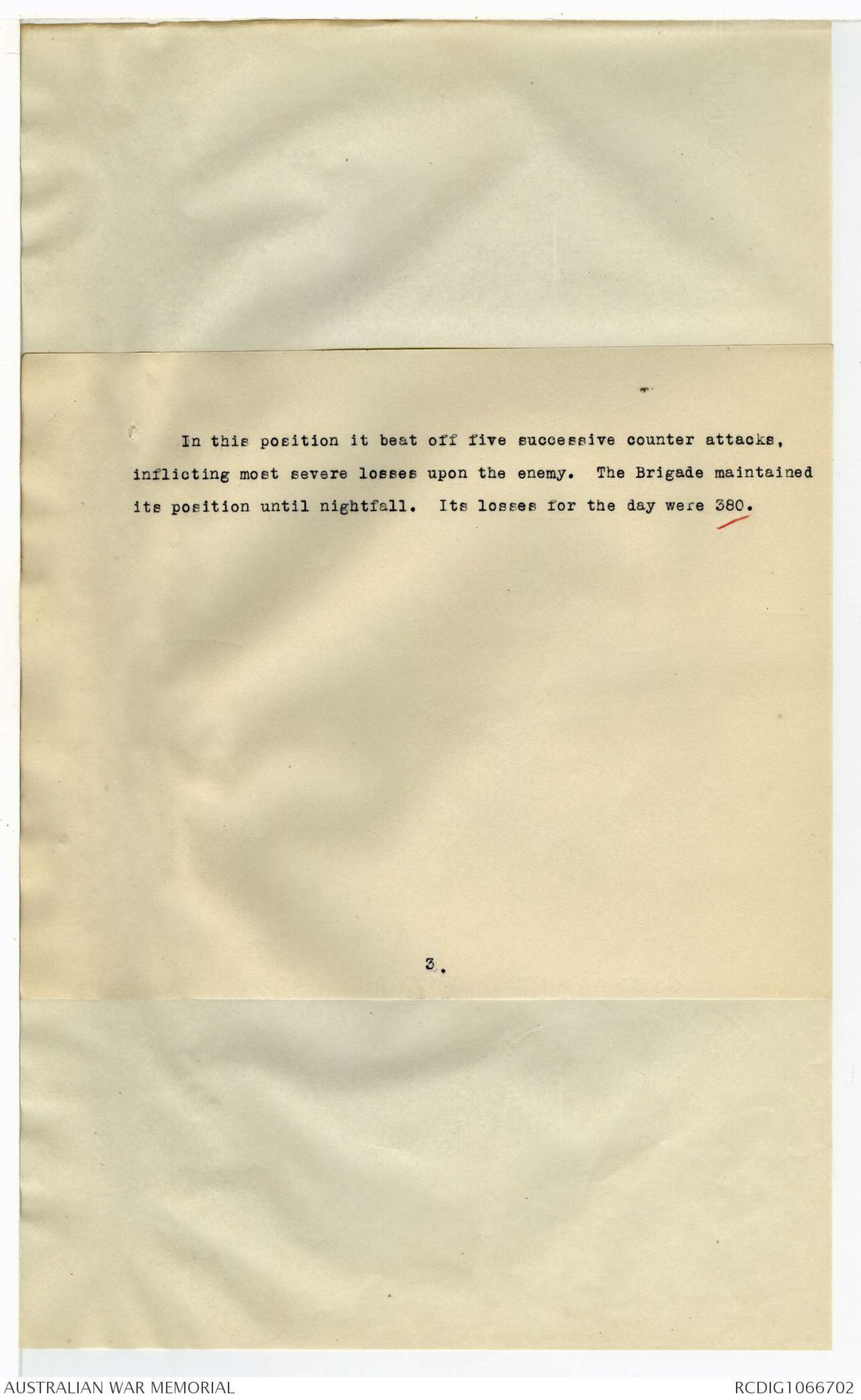

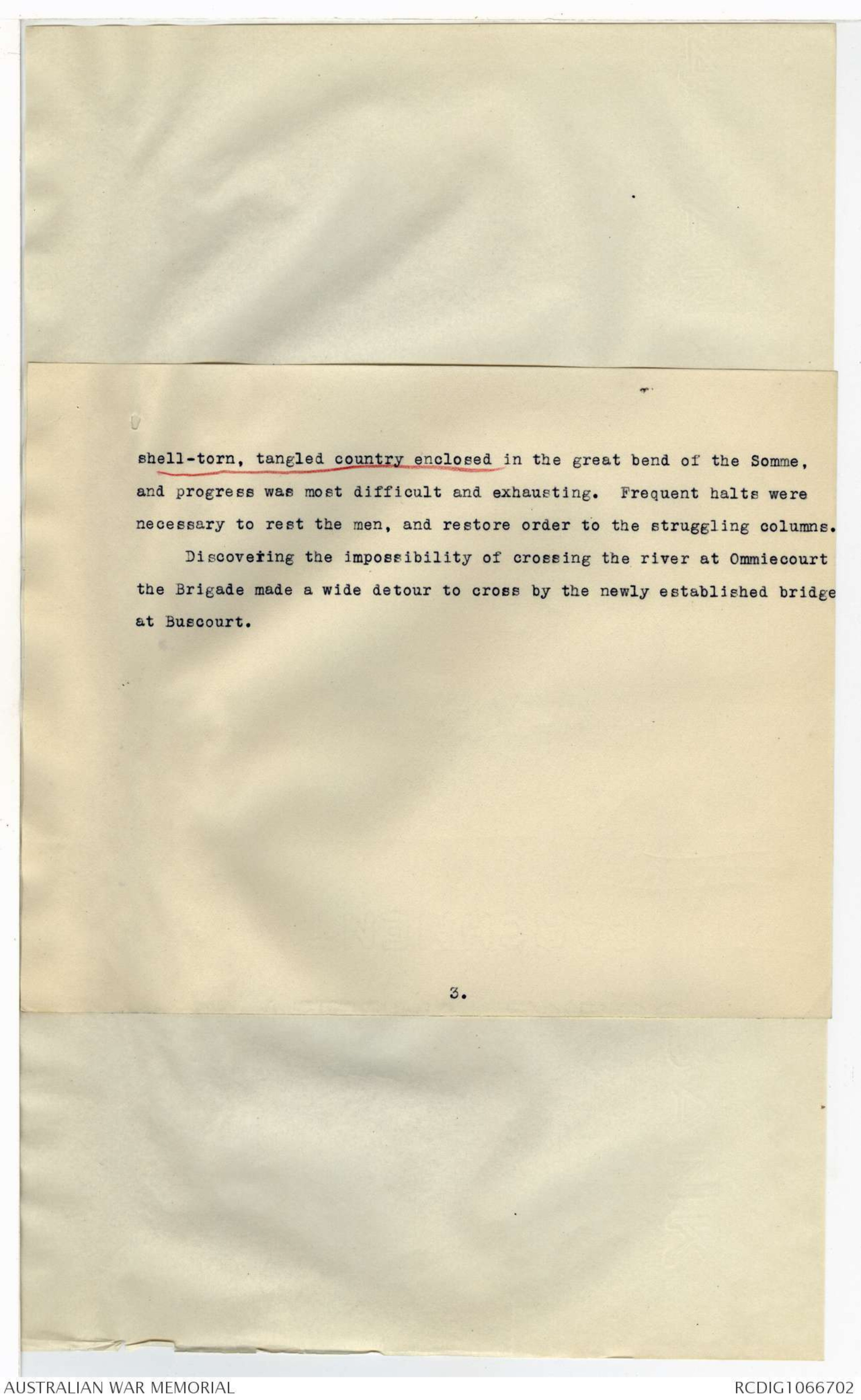


that was the kernel of the plan which now had to be evolved. The
capture of the town of Peronne was consequential upon it, though little
less formidable a task. The effect of both captures would be --
completely to tun the whole line of the Somme to the south, and the
line of the Canal du Nord; to open a wide gate through which the --
remainder of the Fourth and Third Armies could pour, so as to roll
up the enemy's line in both directions.
Page 182.
Extract - Mont St. Quentin and Peronne
From early dawn on Saturday, August 31st, until the evening of
September 3rd, three Divisions of the Australian Corps engaged in a
heroic combat which will ever be memorable in Australian history.
The extraordinary character of this Australian feat of arms
can best be appreciated by a realization of the supreme efforts which
the enemy put forward to prevent it.
The shower of blows which he had received on the front of his
Second Army from August 8th onwards, had wrought upon it a grevious
disorganization. The battered remnants of his line Divisions had
been reinforced from day to day by fresh units, scraped up from other
parts of his front, and thrown into the fight as fast as they could
be made available.
Sometimes they were complete Divisions from Reserve, often
single reserve Regiments of Divisions already deeply involved, and
1
sometimes even single Battalions torn from other Regiments - Pioneer
Battalions, units of the Labour Corps, Army Troops, Minenwerfer
Companies had all been thrown in, indiscriminately.
This brought about a heterogeneous jumble of units, and of
German nationalities, for Prussians, Bavarians, Saxons and Wurtembergers
were captured side by side. The tactical control of such mixed forces,
during a hasty and enforced retreat, and their daily maintenance, must
have presented sore perplexities to the Headquarters of the German Second Army in those fateful days.
To meet the crisis with which Ludendorff was now confronted he
determined to throw in one of the finest of the reserve Divisions still
left at his disposal. The Second Prussian Guards Division was sent
forward to occupy the key position of Mont St. Quentin, and to hold
it at all costs.
This famous Division comprised among its units, the Kaiserin and
the Kaiser Alexander Regiments, almost as famous in history and rich
2
in tradition as are our own Grenadiers and Coldstreams. There is no
doubt that the celebrated Division fought desperately to obey its
instructions.
For the defence of Peronne, the enemy command went even further,
and called for volunteers, forming with them a strong garrison of
picked men drawn from many different line Regiments, to man the ramparts
which surround the town. Dozens of machine guns were posted in vantage
points from which the approaches could be swept.
[*Captured
15 Ag by
5th Div alone
5 field guns
109 M.Gs &
2 minenwerfers*]
All over the river flats lying in the angle of the Somme between
Clery, Mont St. Quentin and Peronne ran line upon line of barbed wire
entanglements, a legacy from the 1916 fighting, and much of this was
still intact, although breaches had been made in many places both by
the French in 1917 and by the Germans themselves to facilitate movement
over the ground, during their respective re-occupations of this
territory.
The terrain, which was in greater part open, and exposed in every
3.
direction to full view from the heights, sloped gently upwards towards
the commanding knoll. Cover was scarce, and the few ruins of brickfields
and sugar refineries which dotted the landscape had also been
garrisoned by the enemy as centres of resistance, designed to break up
and dislocate any general attack.
Our infantry was deprived of the assistance of any Tanks, for the
heavy casualties which had been suffered by this Army made it imperative
to allow the Tank Corps time for repairs, renewals and the training
of fresh crews. Nor was any appreciable quantity of Heavy Artillery
yet available, since the congested and dilapidated condition of the
roads prevented the advance of all but a few of the lighter varieties
of heavy guns.
The fighting of these four days was, therefore, essentially a
pure infantry combat, assisted only by such mobile Artillery of --
lesser calibres as was available.
Such was the formidable nature of the task, and of the disabilities
4
under which the Second, Third and Fifth Divisions approached it.
That they overcame all obstacles, gained all their objectives, and
captured nearly 2,000 prisoners, mainly from crack Prussian regiments
constitutes an achievement memorable in military annals and standing
to the everlasting glory of the troops who took part in it.
Page 185
Plan for attack Sec. P. 178
Extract - Mont St. Quentin and Peronne.
The attack opened with three Battalions of the 5th Brigade in the
first line, and one Battalion in support. The total strength of the
assaulting infantry of this whole Brigade was on this day not more
than 70 Officers and 1,250 other ranks. The centre Battalion was -
directed straight at the highest knoll of Mont St. Quentin, while the
right Battalion prolonged the line to the right. The left Battalion
had assigned to it as an immediate objective the ruins of the village
of Feuillaucourt, from which it was hoped that a flank attack upon the
Mount could be developed.
The advance began at 5 a.m. It was a dull morning and still quite
dark. The two right Battalions advanced with as much noise as --
possible, a ruse which secured the surrender of numbers of the enemy
lying out in advanced outpost positions. A nest of seven Machine Guns
was rushed and captured without any loss to us.
[*Shows
enemy's
best troops
somewhat
demoralized*]
At the appointed hour, our Artillery opened on selected targets
1
the ranges being lengthened from moment to moment in sympathy with the
advance of the Infantry. Although during the advance a great deal of
machine gun fire was encountered all went well. The centre and left
Battalions gained a footing respectively in Feuillaucourt and on the
main hill, but the progress of the right Battalion was arrested by -
heavy machine gun fire from St. Denis. This was the site of a ruined
sugar refinery, and lay on the main road between Peronne and Mont St.
Quentin. It was a strong point that presented a great deal of --
difficulty and held out to the last.
The centre Battalion had by 7 a.m. passed through the ruins of
Mont St. Quentin village and had crossed the main road from Peronne to
Bouchavesnes. It now had to receive the full brunt of a determined
counter attack, at a moment when it was still disorganized and --
breathless from its difficult assault. The Battalion was therefore
withdrawn across the road and firmly established itself in an old
trench system to the west of it.
2
In this position it beat off five successive counter attacks,
inflicting most severe losses upon the enemy. The Brigade maintained
its position until nightfall. Its losses for the day were 380.
3
Page 187
Extract - Mont St. Quentin and Peronne
As soon as I had formed a judgement on the situation, about 8.30
a.m.[*?p.m.*] (August 31st), I issued instructions to General Hobbs immediately
to put in motion his reserve Brigade, the 14th (Stewart). He was to
direct it towards the Ommiecourt crossing, and later in the day to
pass it across the river and through the ground won that morning by
the 5th Brigade, with a view to developing at the earliest possible
moment an attack in a south-easterly direction upon the town of --
Peronne itself. The ultimate objective was still to be the high
ground south and east of Peronne. His 8th Brigade was also to be
held ready to move at the shortest notice.
It was a serious performance to demand, and it was fraught with
many risks. There was no time to assemble responsible commanders
concerned, separated as they were by long distances over bad and
congested roads. In the absence of properly co-ordinated action, there
1
was every chance of confusion, and cross purposes, and even of collision
of authority arising from the troops of one Division passing
over ground under the tactical control of another Division.
But the only alternative was to do nothing and attempt nothing.
That would have been the worst of bad generalship, and it was an
occasion when risks must be taken.
The course of subsequent events fully demonstrated that the only
true solution was the one chosen, for the whole of the defences of
Peronne were thereby taken with a rush, while they were still being
organized by the enemy. The delay of only a day or two would have
meant the capture of Peronne would have been many times more
costly than it actually proved to be.
The 14th Brigade had before it a march of some seven miles to
bring it into a position in which it could deploy for an attack on
Peronne. Working according to text book such a march could have been
accomplished in something under three hours. It took the Brigade over
ten hours. For the line of march lay across the very worst of the
2
shell-torn, tangled country enclosed in the great bend of the Somme,
and progress was most difficult and exhausting. Frequent halts were
necessary to rest the men, and restore order to the struggling columns.
Discovering the impossibility of crossing the river at Ommiecourt
the Brigade made a wide detour to cross by the newly established bridge
at Buscourt.
3
Page 189 (1)
Extract - Mont St. Quentin and Peronne - Confirming the Capture
September 1st was a day full of great happenings and bloody hand
to hand fighting. The assault by the 6th Brigade passing over the line
won the day before by the 5th Brigade carried it well over the crest
of Mont St. Quentin, and confirmed for good and all our hold on that
imperious fortress. Few prisoners were taken, for it was bayonet work
over every inch of the advance, and the field was strewn all over with
enemy dead. The impetus of the 6th Brigade assault carried our
line 600 yards to the east of the summit of the knoll.
[*?
Refer to 5th Div History*]
Page 189 (2)
Extract - Mont St. Quentin and Peronne
Thus the advance on this day of the 6th Brigade materially assisted
the attack on Peronne by the 14th Brigade, while the progress of
the latter removed much trouble from the southern flank of the 6th
Brigade.
The 14th Brigade advanced to the assault at 6 a.m. concurrently
with the eastern thrust of the 6th Brigade. One Battalion, with two
others in support, was directed against St. Denis, while the fourth
made a direct attack on Peronne. Many belts of wire had to be --
struggled through. There was much machine gun fire, from front and
flanks, and it looked as if further progress would be impossible.
Nevertheless, this gallant Brigade, with persistent effort, made itself
master of the western half of Peronne.
Page 190
Extract - Mont St. Quentin and Peronne
The records of the events of these three days are confused and
discontinuous. Many of the men who could have filled the gaps of
the story were unfortunately killed or evacuated as casualties. But
from the mass of reports, the salient facts emerge clearly.
The 15th Brigade succeeded, on September 2nd, in putting a
Battalion across the river, and this assisted the 14th Brigade to "mop
up" the remainder of the town of Peronne. Later the rest of the 15th
Brigade and two Battalions of the 8th Brigade (Tivey)
[*scarcely at all Vide 5th Div History*] were also drawn
into the fighting. St. Denis and the brickfields fell to us during
this period.
[*This is
correct
but the
map which
accompanied
the account of
the Battle
indicated that
they were
taken earlier.
It is wrong.*]
Although the situation, from the point of view of the advance
eastwards, remained almost stationary, it was a time of fierce local
fighting. Many deeds of valour and sacrifice adorn the story.
It was late on September 3rd that the effects of this long
1
sustained struggle became apparent. The whole of Peronne and most of
the high ground in its vicinity were, by then, definitely in our hands,
and although the little suburb of Flamicourt held out determinedly for
another day, the further resistance of the enemy began to fade away.
Doubtless the loss of Mont St. Quentin was a controlling factor
in the decision which was forced upon him to undertake a retreat, for
with that eminence in our possession, he could not have maintained
himself for many days in the town, nor would its retention have been
of any tactical value to him.
As an immediate result, the high ground of the Flamincourt spur
just south of Peronne fell into our hands on September 3rd, and the enemy outposts spread along the banks of the marsh in front of the
32nd Division sought safety from complete envelopment by a hasty
withdrawal; a number of their isolated posts were, however, left
unwarned of this retreat, so that these were, later on, captured by
us from the rear.
2
 Sam scott
Sam scottThis transcription item is now locked to you for editing. To release the lock either Save your changes or Cancel.
This lock will be automatically released after 60 minutes of inactivity.